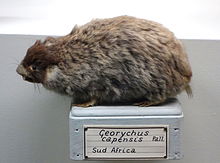Georychus
| Cape mole-rat Temporal range: Middle to Recent |
|
|---|---|
 |
|
| Scientific classification | |
| Kingdom: | Animalia |
| Phylum: | Chordata |
| Class: | Mammalia |
| Order: | Rodentia |
| Family: | Bathyergidae |
| Genus: |
Georychus Illiger, 1811 |
| Species: | G. capensis |
| Binomial name | |
|
Georychus capensis (Pallas, 1778) |
|
| Synonyms | |
|
Mus capensis |
|
Mus capensis
Pallas, 1778
The Cape mole-rat (Georychus capensis) is a species of mole-rat endemic to South Africa. It is the only living species in the genus Georychus.
Cape mole-rats closely resemble other African mole-rats in physical appearance. They have cylindrical bodies with short limbs, and large feet with leathery soles. The head is large and rounded, and the tail is short, with only a few sparse hairs. As with other mole rats, the eyes are very small, and external ears are absent. Adults are around 16 centimetres (6.3 in) in head-body length, with a 2 centimetres (0.79 in) tail, and weigh around 180 grams (6.3 oz). Females have three pairs of teats.
Cape mole-rats can most easily be distinguished from other species of mole-rat by their fur. This is russet in colour over most of the body, with clearly distinct, silvery-white underparts. The head is darker, sometimes even a charcoal grey shade, with prominent white markings around the ears and eyes, and a smaller amount of white fur on the muzzle. The hair on the feet is also white. Unlike the related Damaraland mole-rats, Cape mole-rats have no guard hairs, although there are slightly longer stiff hairs around the mouth and feet, and the animals do have stubby whiskers. Lacking guard hairs, the fur is thick and woolly in texture.
Cape mole-rats inhabit forested and savannah regions across the coastal regions of Western Cape and Eastern Cape provinces in South Africa. Isolated populations have also been reported from KwaZulu-Natal, just east of Lesotho, and from Mpumalanga. Although there are no formally recognised subspecies, this may be due to limited research on the species, and it has been proposed that the mole rats of KwaZulu-Natal may represent an entirely distinct species. They apparently prefer sandy loam, alluvium, or clay soils.
...
Wikipedia

